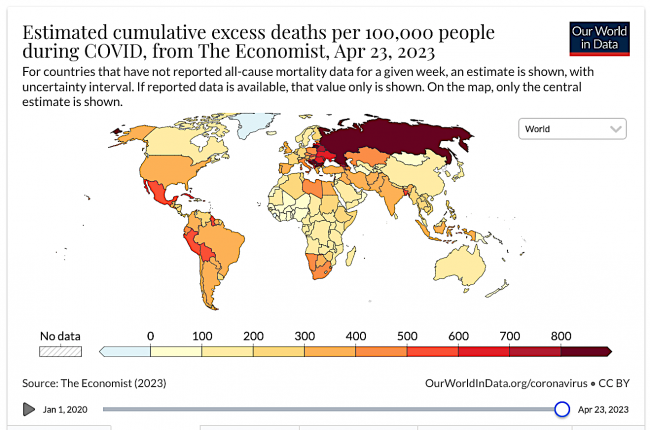
The numbers on the above map are somewhat suspect, but are likely approximately correct. Canada, for example, actually has an unexplained excess death rate 70% higher than the Economist’s estimates on this map (I verified this using the latest Statistics Canada data), so it should be one shade darker on the map, and the same is probably true of a number of other western countries. On the other side, there is evidence that in a lot of African and Asian nations that have little or no reliable health and death data, their IFR is probably significantly lower than this map would suggest, due to their younger demographics and higher immune system health. Globally, these differences tend to balance out to an average excess death toll of 220/100,000 people.
Reminder: I am not a medical expert, but have worked with epidemiologists and have some expertise in research, data analysis and statistics. I am producing these articles in the belief that reasonably researched writing on this topic can’t help but be an improvement over some of what’s currently out there.
The hardest part of dealing with the pandemic now is that the politicians, caving in to the conservative hard-liners and the pandemic-fatigued, have stopped reporting the data, and even in some cases stopped collecting it. Causes of death are often unreported, misreported, inconsistently reported, or not reported until months after the death. In some cases there are multiple causes of, or contributors to, a death. You can look at serology or wastewater reports to get a rough idea of the level of infection, but that doesn’t help much since it changes so fast and so unpredictably. Scientific studies are replete with misinformation and disinformation from disgruntled and publicity-hungry theorists trying to settle professional scores, rescue reputations, make headlines, get grants, or land a guest spot on Faux News.
We still don’t know exactly how this virus evolved, though the overwhelming preponderance of evidence (from actual virologists, not security spooks or racist warmongers) is that it originated naturally in a bat cave in Hunnan and was transported station-to-station by high-speed train to Wuhan from there. We don’t know precisely how it spread to humans, nor do we know how many other equally or more dangerous viruses are out there just waiting to hitch a ride on some wild animal. We actually know very little about viruses, and how they mutate. And we’re still basically clueless on what percentage of the population will have Long CoVid symptoms, possibly for the rest of their lives — estimates differ by an order of magnitude.
So what do we know, with a reasonably high degree of confidence, based on actual, non-cherry-picked, evidence? A few things:
- Like many viruses, as this one mutated into more transmissible variants, those variants also became considerably less lethal. So had we not taken the (inadequate but still rather remarkable) measures we did, especially the use of masks, self-isolating, and vaccination, the death toll from the pandemic would have been many times (likely tens of millions of lost lives) higher. Most of us finally got the virus in its omicron variant, whose fatality rate was much lower (perhaps 75% lower) than the earlier variants.
- The disease has likely killed about 2,200 people per million worldwide, and twice as many in the US and some other countries. That’s about 17 million people worldwide, or one out of every 500 humans, and one out of every 250 Americans (and one out of every 50 Americans over age 65). It was the third leading cause of death in most countries in 2020, 2021 and 2022.
- The disease continues to kill between one and two people per million every day, and ten times that proportion of people over 65. If that continues for another year, 20% of the CoVid-19 deaths are still ahead of us. That’s despite everything we’ve learned about how to protect ourselves from it, and treat it.
- The disease is now endemic — almost everyone has caught it, most asymptomatically, and many have caught it more than once. Overall the IFR (infection fatality rate) has therefore been about 0.2% worldwide and 0.4% in the US and many other countries. The earlier variants had a much higher IFR, perhaps in the area of 1%, and the current variants have a much lower one — your chances now of dying from the disease in the next year are roughly one in 2,000 (and one in 200 if you’re over 65, or immunocompromised). Of course, if you wear a mask, avoid crowded and poorly-ventilated environments, and have your boosters up to date, the risk is much lower.
- Somewhere between 2-4% of the people you encounter each day are likely to be currently infected and infectious. Look at the number of people in the crowded bus with you, or the subway, the restaurant, the club, the classroom, the factory, the office, or the arena, and do the math.
There is not a lot more to say. I agree with the health experts and health journalists who continue to encourage us to use masks in higher-risk indoor and crowded spaces, to get tested when we show symptoms, to self-isolate and let others know when we test positive, and to get all recommended booster shots. And, if you test positive, and are over 60 or immunocompromised, to ask your doctor for antivirals (not monoclonal antibodies which are not effective against Omicron variants).
I also agree with them that we should be collecting and sharing a lot more data, doing much more basic scientific research on infectious diseases, and phasing out factory farms, the hunting and harvesting of exotic animals, and development of our last remaining wilderness areas. And that we should do everything we can to help enable our largely-dysfunctional public health systems to be much, much better prepared for the next pandemic.




